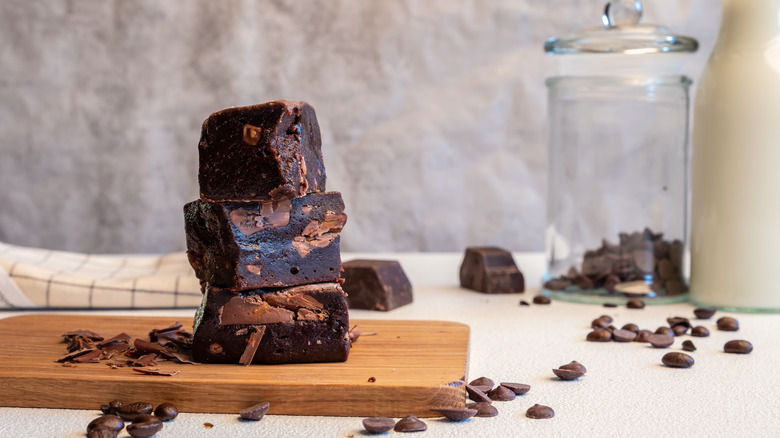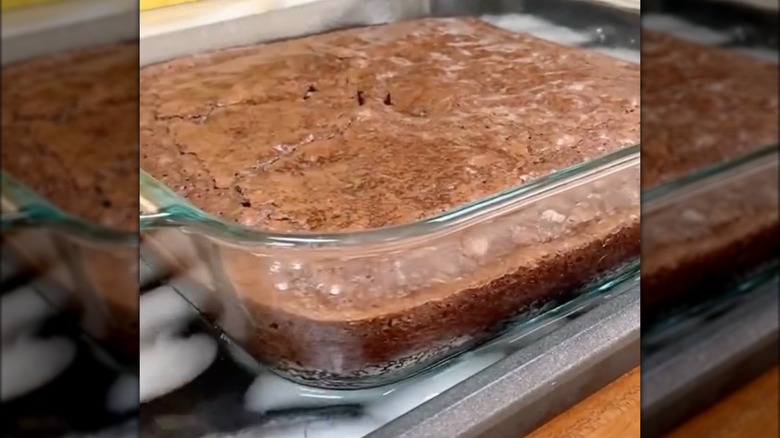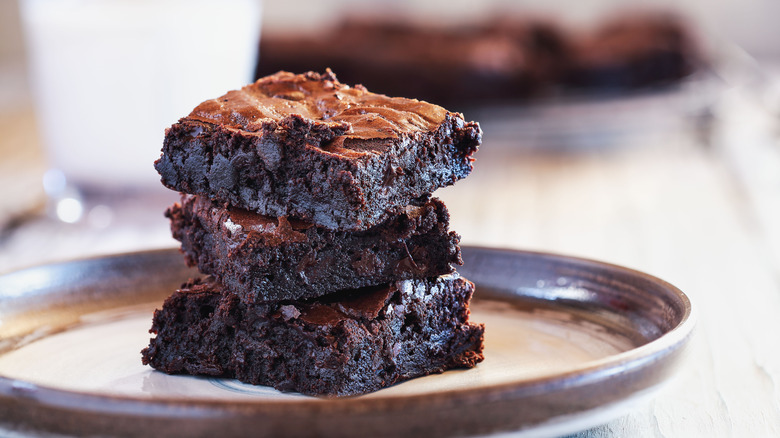Does The Ice Bath Hack Really Make Brownies Better?
If your love language involves sweets, you may have come across TikTok videos proclaiming ways to make brownies better. One of them involves plunging the fresh-out-the-oven tray into an ice bath to create a dense, fudgy treat that's compared to truffles. While we'd love to say, "Yes, it works," or, "No, don't do it," the answer is more complicated.
Giada De Laurentiis, who notoriously loves chocolate, was also curious about the hack and performed a blind taste test on TikTok to see if the hack worked. She prepared two identical boxed brownie mixes, placing one pan in an ice bath and leaving the other to cool naturally. When her resident guinea pig (aka her boyfriend Shane) tried both brownies, he preferred the one that wasn't rapidly cooled. While De Laurentiis' experiment is undoubtedly subjective and inconclusive, it raises doubts about the hack.
@giadadelaurentiis Heard about this technique and had to try it! #brownies #icedunkedbrownies #icedbrownies #chocolatebrownies #brownierecipe
The theory behind the ice bath method is that if you rapidly cool the brownies as soon as you remove them from the oven, you will halt carry-over cooking, maintaining their fresh-out-of-the-oven texture. While this method may work for undercooked brownies and enable you to cut them sooner (which is a big win), it may not have the desired effect. When the hot pan is placed in ice water, it will produce steam, which will get trapped, creating a denser, cakey brownie instead of the desired gooey finish. In addition, shocking your bakeware may cause bigger problems than a cakey brownie.
Reasons to avoid the ice bath hack
The internet is full of similar methods, showing individuals putting brownie pans in the freezer or the fridge for the same reason. Some proclaim that the rapid cooling reversed the cooking process, turning overbaked, dry brownies into fudgy sweets. While any brownie is a good brownie, whether this hack works or not is only part of the equation.
Baking is a science that requires precision to get the desired results. Chemistry can explain why something is tender or chewy, but the laws of physics spell out why this hack may not be a good idea to try. In nature, a convergence of hot and cold can cause a tornado. Well, in the kitchen, the drastic temperature change may damage your pan (slightly less terrifying). If you use a glass or Pyrex pan, similar to the bakeware Giada De Laurentiis used for her experiment, thermal shock can cause the hot, brittle glass to explode like a bomb when placed in cold water. If you've experienced this failure when trying to wash a hot casserole pan, you know this isn't an exaggeration; it's loud and messy.
For this reason, bakeware should be cooled before being put in ice water or the freezer. Metal pans are more flexible; however, this hack may cause them to warp, leading to uneven cooking in the future. Rest assured, there are other ways to make a better brownie.
Tips for preparing fudgy brownies
If you prefer fudgy versus cakey brownies, there are a few things to consider before you start baking — and none involve an ice bath. When preparing the brownies from scratch, use a recipe that describes the type it will make. Generally, gooey, fudgy brownies have a higher fat-to-flour ratio and don't contain a chemical leavener. Additional fat may come from oil, butter, chocolate, or dairy. Be careful when making substitutions, however, as they may change the brownie's texture and baking time. Although it seems like a harmless change, if the recipe calls for Dutch-process cocoa, using natural cocoa will produce a denser baked good.
For a fudgy texture, also avoid overcooking the batter and check for doneness a few minutes before the recipe says it should be done. When brownies are removed from the oven, they continue to cook as they cool. If you wait until a cake tester or toothpick comes out clean, by the time they are cool enough to cut, the brownies will be overcooked, especially the edge pieces (check out Martha Stewart's hack for improving their flavor).
The center should still be a bit moist, and some crumbs should cling to the tester. For a more scientific approach, try Alton Brown's bake-and-pause technique to make his unbeatable brownies — he removes the brownie pan halfway through baking to cool it and then returns it to the oven to finish cooking.



